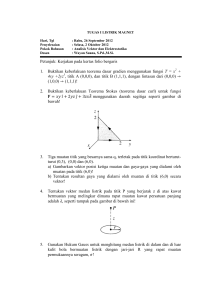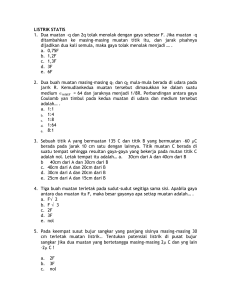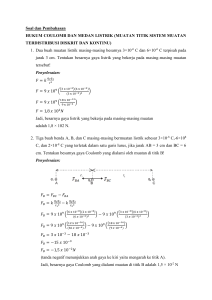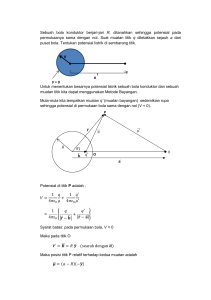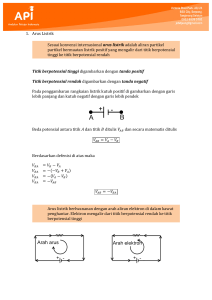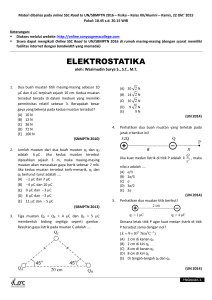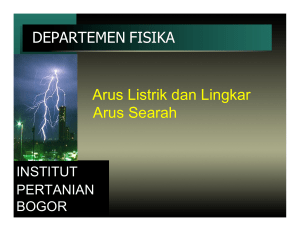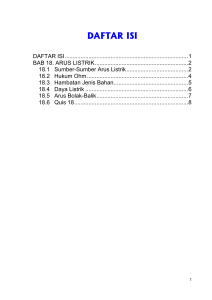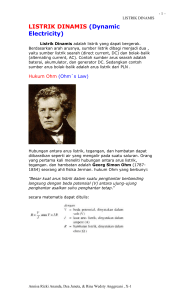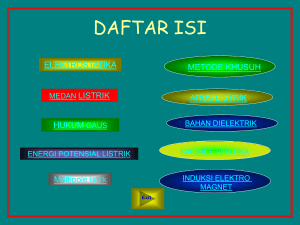e t RC Q q dt RC q dq q RC dt dq
advertisement
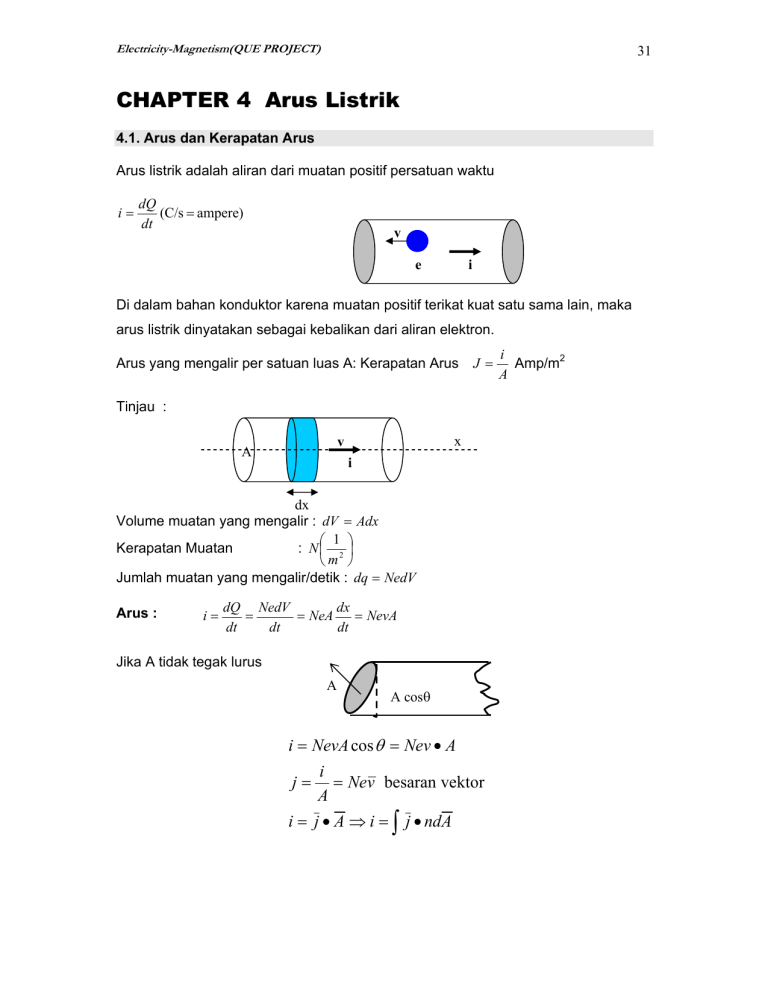
Electricity-Magnetism(QUE PROJECT) 31 CHAPTER 4 Arus Listrik 4.1. Arus dan Kerapatan Arus Arus listrik adalah aliran dari muatan positif persatuan waktu i= dQ (C/s = ampere) dt v e i Di dalam bahan konduktor karena muatan positif terikat kuat satu sama lain, maka arus listrik dinyatakan sebagai kebalikan dari aliran elektron. Arus yang mengalir per satuan luas A: Kerapatan Arus J= Tinjau : x v A i dx Volume muatan yang mengalir : dV = Adx ⎛ 1 ⎞ Kerapatan Muatan : N⎜ 2 ⎟ ⎝m ⎠ Jumlah muatan yang mengalir/detik : dq = NedV Arus : i= dQ NedV dx = = NeA = NevA dt dt dt Jika A tidak tegak lurus A A cosθ i = NevA cos θ = Nev • A j= i = Nev besaran vektor A i = j • A ⇒ i = ∫ j • ndA i Amp/m2 A Electricity-Magnetism(QUE PROJECT) 32 4.2. Hambatan dan Hukum Ohm Hambatan listrik : halangan gerak muatan ketika mengalir • tabrakan sesama muatan • tabrakan dengan muatan dari atom , zat lain, dll. Bahan Konduktor : banyak elektron bebas : ⇒ Selalu bergerak acak dengan kecepatan vi. ⇒ ∑v i = 0 ⇒ i = NevA = 0 i ∑viτi ⇒ vdrift = t ∑ vdrift <<vi i ⇒ menghasilkan arus Bila diberi medan listrik E : 1. bergerak menuju satu arah 2. ∑v i ≠0 3. i = NevA ≠ 0 4. akan terjadi tabrakan→hambatan me = massa e l = jarak bebas rata-rata τ = waktu relaksasi v` = kecepatan sebelum tumbukan v`` = kecepatan sesudah tumbukan Bila tumbukan elastis : v`=v``=v Δ (mv) = me v`− me v``= me v + me v = 2me v Δ (mv) = F • Δτ Hukum Kekekalan Impuls=momentum : Δ (mv) = FΔτ ; Δt = 2τ 2me v = 2eEτ eτ v= E me I≺E ; i = NevA I ≺v mev` l Electricity-Magnetism(QUE PROJECT) 33 J= i e 2τ =N E A me e 2τ = konduktansi ( kemampuan hantar muatan bahan) me 1 m J = gE ; g= ; ρ= ; ρ Ne 2τ g= i= since V pot = E • L thus : Ne 2τ V i= A me L i= Conductor Ne 2τ AE me V pot R ; 1A 1 = ρL R ⇒ V = iR N≈1027/m3 : Tergantung temperatur : bila temperatur dinaikkan L dan τ mengecil, ρ membesar Nonconductor : N≈0 g=0, ρ→∞ Semiconductor: g antara conductor dan nonconductor. T rendah, sifatnya sama seperti nonconductor. T mendekati temperatur ruang, hambatan turun bila bahan dipanaskan. Resistor dan rangkaiannya a. Seri i V1 V2 R1 R2 i = konstan disetiap cabang v=v1+v2+…..+vn R=Σ Ri V = iR = i ( R1 + R2 + ...... Rn ) Electricity-Magnetism(QUE PROJECT) 34 b. Paralel V di setiap titik cabang konstan i=i1+i2+i3+…..+in 1 1 1 i = v( + + ...... + ) R1 R2 Rn i i1 R1 i2 R2 in Rn n 1 1 =∑ R i =1 Rn i Potensiometer : Pembagi potensial Pengukur potensial Rheostat (hambatan variabel) Pembagi potensial i Vin R1 R2 V in = i ( R 1 + R 2 ) V out = iR 2 V in = V out ( R1 + R 2 ) R2 V out = R2 V in R1 + R 2 Vout Electricity-Magnetism(QUE PROJECT) 35 Pengukur potensial Galvanometer E R εx Bila arus pada galvanometer = 0 Ex = Where εx replace by εs and R by Rs Rheostat Rx E s tan dar Rs : Contoh lain : εx r G i I i0 II R ( i0 - i ) R0 In loop I : − ε x − ir + (i0 − i) R = 0 i= i0 R − ε x R+r E0 Electricity-Magnetism(QUE PROJECT) 36 Replace εx by a standard emf εs and then adjust again R to the zero circuit condition. R = variable resistor i0 R x = ε x , i=0 If R is adjusted to have the value Rx where, i0 R s = ε s εx = εs Rx Rs 4.3. Daya Disipasi dan GGL Daya Disipasi : Besar energi listrik per satuan waktu melalui hambatan yang berubah menjadi energi dalam bentuk panas. dq ε W = ∫ Vdq , daya : V dW = Vi ( watt ) dε P = i2R P= Daya ini merupakan kerja persatuan waktu untuk melawan gerak muatan sehingga menimbulkan panas. Gaya Gerak Listrik (GGL), ε : merupakan energi persatuan muatan untuk menggerakkan muatan yang berasal dari sumber luar. Sumber GGL : Energi kimia : Energi matahari : Energi Panas bumi. 1. elemen listrik (battery) 2. bahan bakar fosil 1. panas dan cahaya 2. energi gravitasi 3. ombak dan angin Electricity-Magnetism(QUE PROJECT) 37 W = ∫ εdq ε= ` dw ` ( watt ) dq Beda potensial dan ggl : Potensial → statis Ggl → dinamis Di dalam sumber listrik pada saat muatan digerakkan, akan timbul hambatan Rd setelah akan mencapai keadaan setimbang, arus yang mengalir I baik pada beban R maupun Rd tetap. a dq Rd V ε b εu = (R + Rd )i Vad = ε − iRd Bila Rd ⇒ ∞ , seluruh gerak muatan dihambat, i = 0, ε = 0 Contoh : 10Ω 5.0Ω 8.7Ω 0.5Ω 9V A 9.0 V battery whose internal resistance r=0.5Ω is connected as the figure. H ow much current is drawn from the battery? What is the therminal voltage of battery ? Electricity-Magnetism(QUE PROJECT) RT = ( I= 38 10 × 8.7 R1 R2 )+5= ( ) + 5 = 10.3Ω 18.7 R1 + R2 ε RT = 9 = 0.87 Amp 10 .3 Va = ε − ir = 9 − (0.87 )(0.5) = 8.6V 4.4. Hukum Kirchoff I. ∑ε − ∑i R i j j =0 i II. ∑i j Contoh =0 : R2 1. i2 i3 R1 i4 i1 R3 I : ε − i1 R1 − i2 R2 − i1 ( II : i1 - i3 i1 = i2 R3 R4 )=0 R3 + R4 - R2 i2 2. Jembatan Wheatstone R4 i4 = 0 R3 i3 b c R5 i5 a R6 i R1 i1 d ε R4 i4 Electricity-Magnetism(QUE PROJECT) 39 A ⇒ ε − i1 R 1 − i1 R 4 − iR 6 = 0 B ⇒ i 2 R 2 + i 5 R 5 − i1 R 1 = 0 C ⇒ i5 R 5 + i 4 R 4 − i3 R 3 = 0 a ⇒ i − i1 − i 2 = 0 b ⇒ i2 − i3 − i5 = 0 c ⇒ i3 + i4 − i = 0 d ⇒ i1 + i 5 − i 4 = 0 R5 is variable, where i5=0 Thus, R1 R2 = R4 R3 4.5. Nonohmik Konduktor Conducting material that obey Ohm`s Law ( Δv = Ri or j = σε ) are designated as Ohmik or linear conductors, because of the direct proposionality between the voltage and current. →most solid(mainly metal) or many liquids. Gase on conduction departs markedly from Ohm`s Law, primarly because conduction in gases is due not to the presence of free electrons bbut to the production of ionized atoms or molecules, ( by passing high frequency EM radiation : X-rays,γ-rays, or by uncreasing the temperature of the gases to ≈ 1000K). Metals depart from Ohm`s Law at very low temperature, because when temperature is very low, the energy of the conduction electrons and of the lattice ions is extremely small. The motion of the electrons is less hundred bby lattice vibrations and conductivity increases appreciably. Electricity-Magnetism(QUE PROJECT) 40 In some substance, superconductors, the conductivity effectively becomes infinite near absolute zero. There are some conducting solids that do not obey Ohm`s Law even at room temperature⇒non-ohmic conductors : ceramic, semiconductor,p-n junctions, boundary layers between metals and their oxide. Iron alloy filament in hidrogen atmosphere. I(A) Carbon Tungsten Lamp filament characteristic ΔV (Volt) I (A) ΔV (V) Asymmetric system CaCuO ( current not only depend on magnitude of applied voltage but also on the direction invalid the voltage is applied) Metallic copper caused with a layer of copper oxide Electricity-Magnetism(QUE PROJECT) 41 4.6. RC-Circuits Time varying currents a R s b C ε i= dq ⇒ dq = idt dt if S on at a : the work done by emf must equal the energy that appear as the thermal energy in R during time dt ( i2R dt ) plus the increase in the amount of energy U that is stored in ⎛ q2 ⎞ ⎟⎟ ). the capacitor ( dU = d ⎜⎜ ⎝ 2C ⎠ ε dq = i 2 Rdt + d ( ε dq = i 2 Rdt + q2 ) 2C q dq C Dividing by dε : ε dq q dq = i2R + dε C dε ε = iR + q C Electricity-Magnetism(QUE PROJECT) From loop : Differential equation : ⇒ Solution at ε R q = 0 C ε − iR − ε = R dq q + dt C q = C ε (1 − e : E=0, q=0 , i = 42 dq dt , = i = ε R e t RC − ) t − RC t ⇒ ∞ , q ⇒ Cε , i=0 q Cε Vc Va i ε R t RC = Capacity time constant, the charge on the capacitor has increased to a factor ( (1 − e −1 ) and q = 0.63 Cε. If S is in b after the capacitor is fully charged : Electricity-Magnetism(QUE PROJECT) 43 iR + R dq dt q C = 0 q C + q = q 0e i = − ⇒ ε R − e = 0 t RC − t RC , q0=Cε 1 dq = q dt RC q ∫ Q0 1 dq = − q RC t ∫ dt 0 q 1 ln = − t Q0 RC ⇒ q = Q 0e − t RC
